Improved Performance of Electron Blocking Layer Free AlGaN Deep Ultraviolet Light-Emitting Diodes Using Graded Staircase Barriers
Abstract
:1. Introduction
2. Device Structure and Parameters
3. Results
4. Conclusions
Author Contributions
Funding
Conflicts of Interest
References
- Kneissl, M.; Seong, T.Y.; Han, J.; Amano, H. The emergence and prospects of deep-ultraviolet light-emitting diode technologies. Nat. Photonics 2019, 13, 233–244. [Google Scholar] [CrossRef]
- Muramoto, Y.; Kimura, M.; Nouda, S. Development and future of ultraviolet light-emitting diodes: UV-LED will replace the UV lamp. Semicond. Sci. Technol. 2014, 29, 084004. [Google Scholar] [CrossRef] [Green Version]
- Cho, J.; Schubert, E.F.; Kim, J.K. Efficiency droop in light-emitting diodes: Challenges and countermeasures. Laser Photonics Rev. 2013, 7, 408–421. [Google Scholar] [CrossRef]
- Hirayama, H.; Fujikawa, S.; Noguchi, N.; Norimatsu, J.; Takano, T.; Tsubaki, K.; Kamata, N. 222–282 nm AlGaN and InAlGaN-based deep-UV LEDs fabricated on high-quality AlN on sapphire. Phys. Stat. Solid A 2009, 206, 1176–1182. [Google Scholar] [CrossRef]
- Velpula, R.T.; Jain, B.; Bui, H.Q.T.; Shakiba, F.M.; Jude, J.; Tumuna, M.; Nguyen, H.D.; Lenka, T.R.; Nguyen, H.P.T. Improving carrier transport in AlGaN deep-ultraviolet light-emitting diodes using a strip-in-a-barrier structure. Appl. Opt. 2020, 59, 5276–5281. [Google Scholar] [CrossRef] [PubMed]
- Nam, K.; Nakarmi, M.; Li, J.; Lin, J.; Jiang, H. Mg acceptor level in AlN probed by deep ultraviolet photoluminescence. Appl. Phys. Lett. 2003, 83, 878–880. [Google Scholar] [CrossRef]
- Li, Y.; Chen, S.; Tian, W.; Wu, Z.; Fang, Y.; Dai, J.; Chen, C. Advantages of AlGaN-based 310-nm UV light-emitting diodes with Al content graded AlGaN electron blocking layers. IEEE Photonics J. 2013, 5, 8200309. [Google Scholar]
- So, B.; Kim, J.; Kwak, T.; Kim, T.; Lee, J.; Choi, U.; Nam, O. Improved carrier injection of AlGaN-based deep ultraviolet light emitting diodes with graded superlattice electron blocking layers. RSC Adv. 2018, 8, 35528–35533. [Google Scholar] [CrossRef] [Green Version]
- Zhang, Z.H.; Chen, S.W.H.; Chu, C.; Tian, K.; Fang, M.; Zhang, Y.; Bi, W.; Kuo, H.C. Nearly efficiency-droop-free AlGaN-based ultraviolet light-emitting diodes with a specifically designed superlattice p-type electron blocking layer for high mg doping efficiency. Nanoscale Res. Lett. 2018, 13, 122. [Google Scholar] [CrossRef] [Green Version]
- Jain, B.; Velpula, R.T.; Velpula, S.; Nguyen, H.D.; Nguyen, H.P.T. Enhanced hole transport in AlGaN deep ultraviolet light-emitting diodes using a double-sided step graded superlattice electron blocking layer. J. Opt. Soc. Am. 2020, 37, 2564–2569. [Google Scholar] [CrossRef]
- Liu, B.M.C.; Zhang, J. AlGaN-Delta-GaN Quantum Well for DUV LEDs. Photonics 2020, 7, 87. [Google Scholar] [CrossRef]
- Ren, Z.; Lu, Y.; Yao, H.H.; Sun, H.; Liao, C.H.; Dai, J.; Chen, C.; Ryou, J.H.; Yan, J.; Wang, J. III-nitride deep UV LED without electron blocking layer. IEEE Photonics J. 2019, 11, 1–11. [Google Scholar] [CrossRef]
- Velpula, R.T.; Jain, B.; Velpula, S.; Nguyen, H.D.; Nguyen, H.P.T. High-performance electron-blocking-layer-free deep ultraviolet light-emitting diodes implementing a strip-in-a-barrier structure. Opt. Lett. 2020, 45, 5125–5128. [Google Scholar] [CrossRef]
- Velpula, R.T.; Jain, B.; Bui, H.Q.T.; Pham, T.T.; Nguyen, H.-D.; Lenka, T.R.; Nguyen, H.P.T. Numerical investigation on the device performance of electron blocking layer free AlInN nanowire deep ultraviolet light-emitting diodes. Opt. Mater. Express 2020, 10, 472–483. [Google Scholar] [CrossRef]
- Wang, N.; Yin, Y.A.; Zhao, B.; Mei, T. Performance analysis of GaN-based light-emitting diodes with lattice-matched InGaN/AlInN/InGaN quantum-well barriers. J. Disp. Technol. 2015, 11, 1056–1060. [Google Scholar] [CrossRef]
- Jain, B.; Velpula, R.T.; Bui, H.Q.T.; Nguyen, H.D.; Lenka, T.R.; Nguyen, T.K.; Nguyen, H.P.T. High performance electron blocking layer-free InGaN/GaN nanowire white-light-emitting diodes. Opt. Express 2020, 28, 665–675. [Google Scholar] [CrossRef] [PubMed]
- Pan, C.C.; Yan, Q.; Fu, H.; Zhao, Y.; Wu, Y.R.; van de Walle, C.; Nakamura, S.; DenBaars, S.P. High optical power and low-efficiency droop blue light-emitting diodes using compositionally step-graded InGaN barrier. Electron. Lett. 2015, 51, 1187–1189. [Google Scholar] [CrossRef] [Green Version]
- Xiong, J.Y.; Xu, Y.Q.; Zheng, S.W.; Fan, G.H.; Zhang, T. Advantages of blue InGaN light-emitting diodes without an electron-blocking layer by using AlGaN step-like barriers. Appl. Phys. A 2014, 114, 309–313. [Google Scholar] [CrossRef]
- Ni, X.; Li, X.; Lee, J.; Liu, S.; Avrutin, V.; Özgür, Ü.; Morkoç, H.; Matulionis, A. Hot electron effects on efficiency degradation in InGaN light emitting diodes and designs to mitigate them. J. Appl. Phys. 2010, 108, 033112. [Google Scholar] [CrossRef] [Green Version]
- Xing, C.; Yu, H.; Ren, Z.; Zhang, H.; Dai, J.; Chen, C.; Sun, H. Performance improvement of AlGaN-based deep ultraviolet light-emitting diodes with step-like quantum barriers. IEEE J. Quantum Electron. 2019, 56, 1–6. [Google Scholar] [CrossRef]
- Yan, J.; Wang, J.; Zhang, Y.; Cong, P.; Sun, L.; Tian, Y.; Zhao, C.; Li, J. AlGaN-based deep-ultraviolet light-emitting diodes grown on high-quality AlN template using MOVPE. J. Cryst. Growth 2015, 414, 254–257. [Google Scholar] [CrossRef]
- Varshni, Y.P. Temperature dependence of the energy gap in semiconductors. Physica 1967, 34, 149–154. [Google Scholar] [CrossRef]
- Piprek, J. Nitride Semiconductor Devices: Principles and Simulation; Wiley Online Library: Berlin, Germany, 2007. [Google Scholar]
- Coughlan, C.; Schulz, S.; Caro, M.A.; O’Reilly, E.P. Band gap bowing and optical polarization switching in Al Ga N alloys. Phys. Stat. Solidi 2015, 252, 879–884. [Google Scholar] [CrossRef]
- Caughey, D.; Thomas, R. Carrier mobilities in silicon empirically related to doping and field. Proc. IEEE 1967, 55, 2192–2193. [Google Scholar] [CrossRef]
- Chuang, S.; Chang, C. k⋅ p method for strained wurtzite semiconductors. Phys. Rev. 1996, 54, 2491. [Google Scholar] [CrossRef]
- Yun, J.; Shim, J.I.; Hirayama, H. Analysis of efficiency droop in 280-nm AlGaN multiple-quantum-well light-emitting diodes based on carrier rate equation. Appl. Phys. Express 2015, 8, 022104. [Google Scholar] [CrossRef]
- Fiorentini, V.; Bernardini, F.; Ambacher, O. Evidence for nonlinear macroscopic polarization in III–V nitride alloy heterostructures. Appl. Phys. Lett. 2002, 80, 1204–1206. [Google Scholar] [CrossRef]
- Vurgaftman, I.; Meyer, J.N. Band parameters for nitrogen-containing semiconductors. J. Appl. Phys. 2003, 94, 3675–3696. [Google Scholar] [CrossRef]
- Ji, X.; Yan, J.; Guo, Y.; Sun, L.; Wei, T.; Zhang, Y.; Wang, J.; Yang, F.; Li, J. Tailoring of energy band in electron-blocking structure enhancing the efficiency of AlGaN-based deep ultraviolet light-emitting diodes. IEEE Photonics J. 2016, 8, 1–7. [Google Scholar] [CrossRef]
- Zhang, Z.H.; Liu, W.; Tan, S.T.; Ju, Z.; Ji, Y.; Kyaw, Z.; Zhang, X.; Hasanov, N.; Zhu, B.; Lu, S. On the mechanisms of InGaN electron cooler in InGaN/GaN light-emitting diodes. Opt. Express 2014, 22, A779–A789. [Google Scholar] [CrossRef] [Green Version]
- Kuball, M. Raman spectroscopy of GaN, AlGaN and AlN for process and growth monitoring/control. Surf. Interface Anal. 2001, 31, 987–999. [Google Scholar] [CrossRef]
- SaifAddin, B.K.; Almogbel, A.S.; Zollner, C.J.; Wu, F.; Bonef, B.; Iza, M.; Nakamura, S.; DenBaars, S.P.; Speck, J.S. AlGaN deep-ultraviolet light-emitting diodes grown on SiC substrates. ACS Photonics 2020, 7, 554–561. [Google Scholar] [CrossRef]
- Hu, J.; Zhang, J.; Zhang, Y.; Zhang, H.; Long, H.; Chen, Q.; Shan, M.; Du, S.; Dai, J.; Chen, C. Enhanced performance of AlGaN-based deep ultraviolet light-emitting diodes with chirped superlattice electron deceleration layer. Nanoscale Res. Lett. 2019, 14, 1–8. [Google Scholar] [CrossRef] [PubMed] [Green Version]
- Ni, R.; Chuo, C.C.; Yang, K.; Ai, Y.; Zhang, L.; Cheng, Z.; Liu, Z.; Jia, L.; Zhang, Y. AlGaN-based ultraviolet light-emitting diode on high-temperature annealed sputtered AlN template. J. Alloy Compd. 2019, 794, 8–12. [Google Scholar] [CrossRef]
- Jmerik, V.; Shubina, T.; Mizerov, A.; Belyaev, K.; Sakharov, A.; Zamoryanskaya, M.; Sitnikova, A.; Davydov, V.Y.; Kop’ev, P.; Lutsenko, E. AlGaN quantum well structures for deep-UV LEDs grown by plasma-assisted MBE using sub-monolayer digital-alloying technique. J. Cryst. Growth 2009, 311, 2080–2083. [Google Scholar] [CrossRef]
- Liao, Y.; Thomidis, C.; Kao, C.K.; Moustakas, T.D. AlGaN based deep ultraviolet light emitting diodes with high internal quantum efficiency grown by molecular beam epitaxy. Appl. Phys. Lett. 2011, 98, 081110. [Google Scholar] [CrossRef] [Green Version]

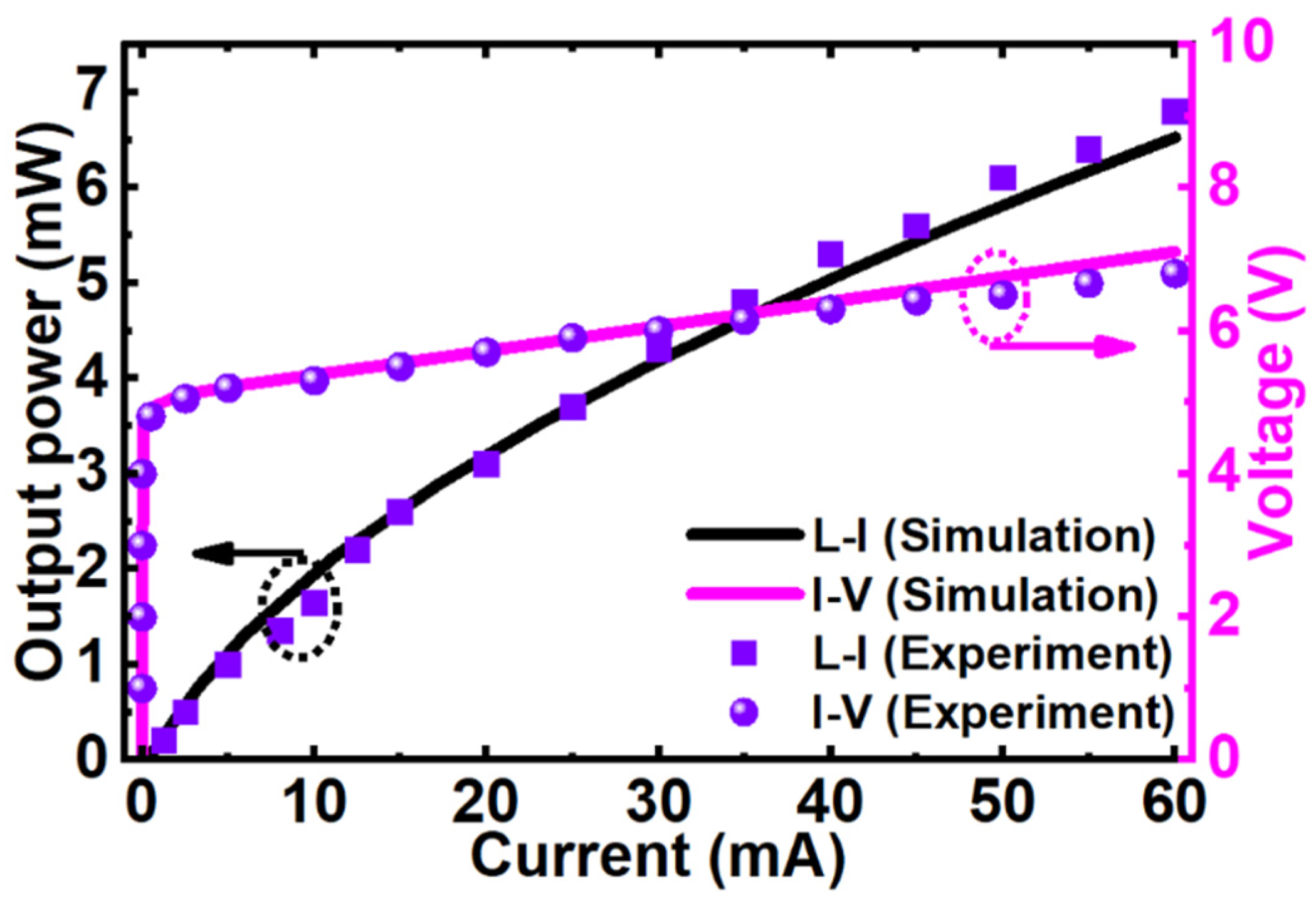
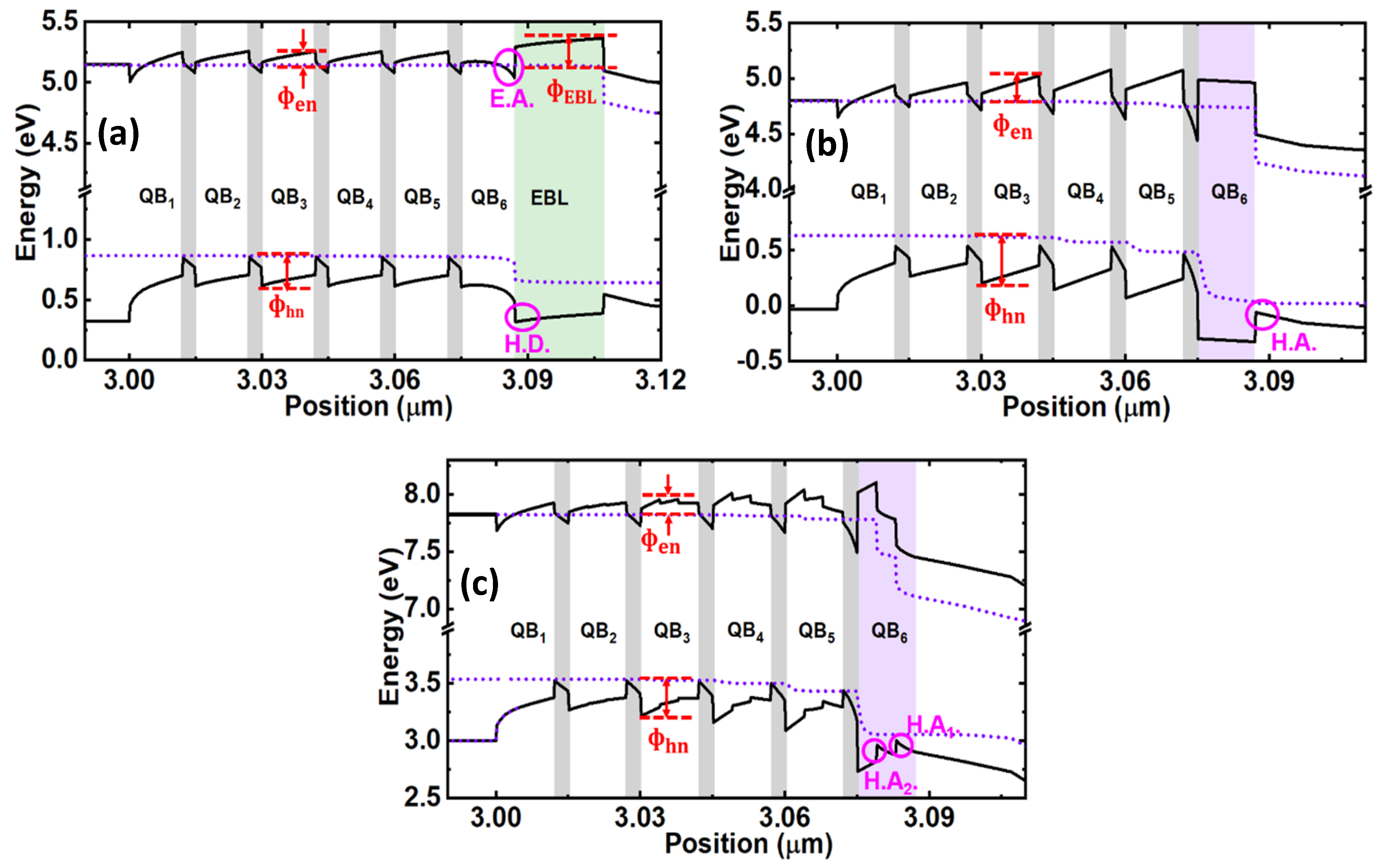
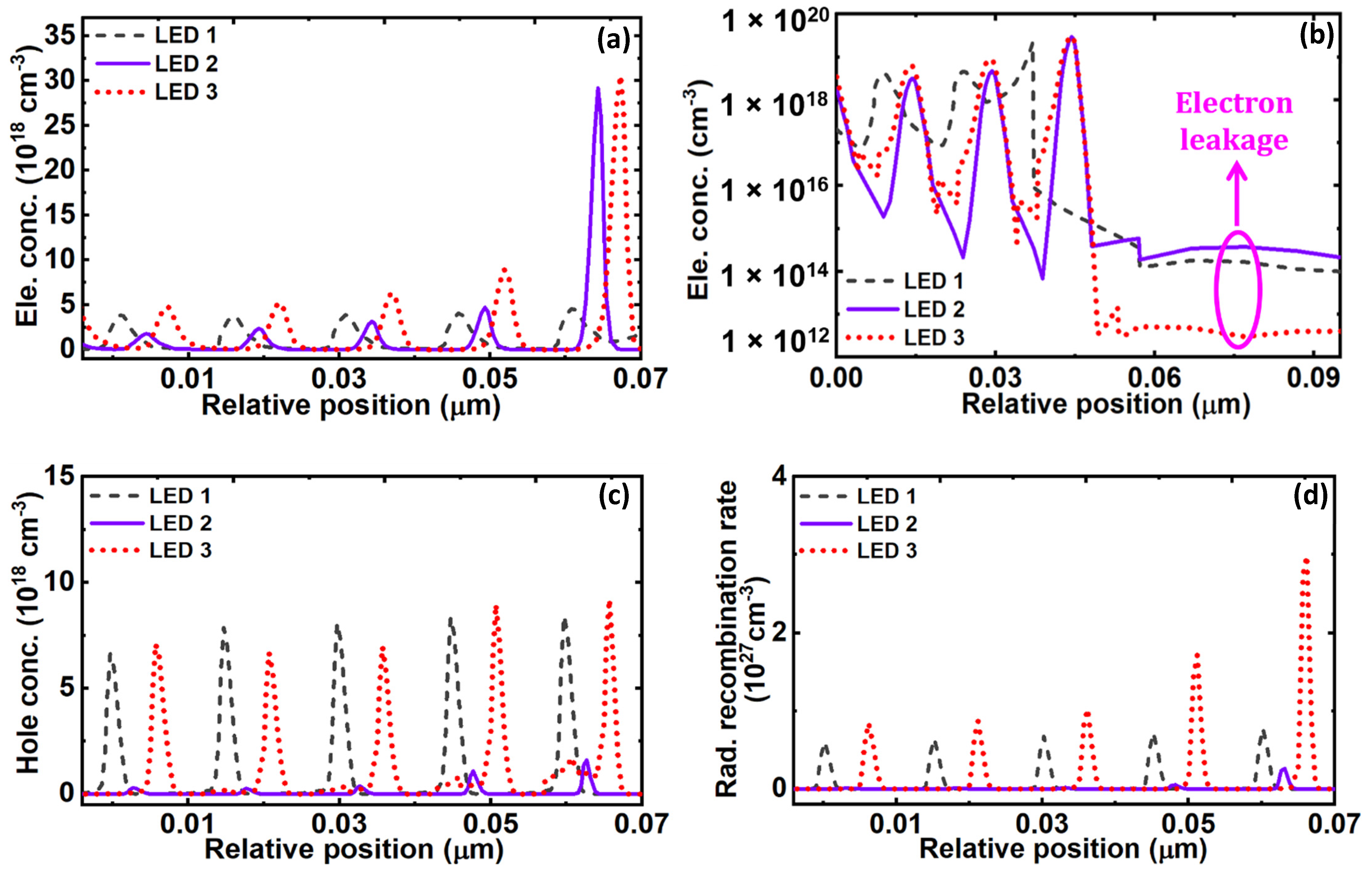
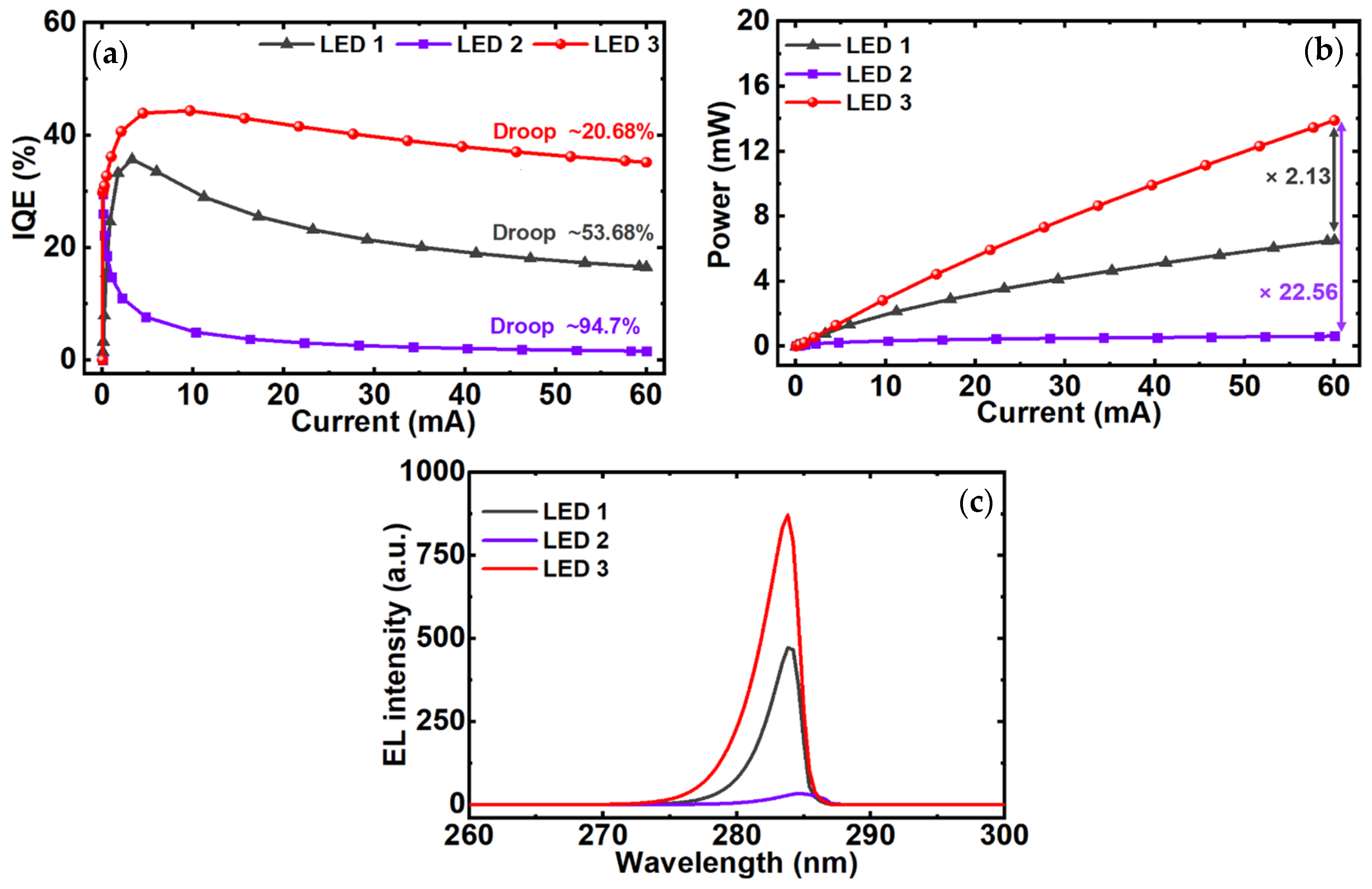
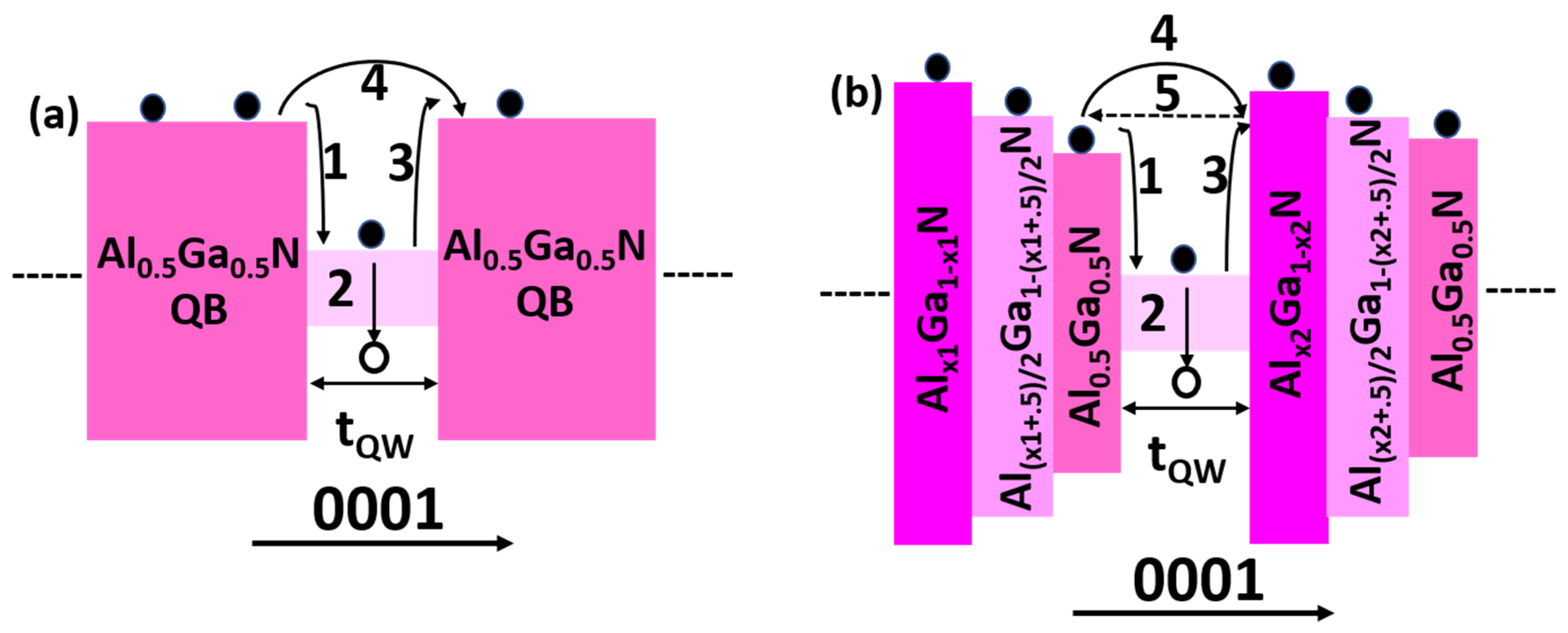

| Conduction Band Barrier Heights (CBBH) | LED 1 | LED 2 | LED 3 |
|---|---|---|---|
| фe2 | 114.3 meV | 167.3 meV | 104.42 meV |
| фe3 | 113.8 meV | 232.6 meV | 134.77 meV |
| фe4 | 112.6 meV | 300.6 meV | 191.15 meV |
| фe5 | 110.1 meV | 330.1 meV | 230.22 meV |
| фe6 | 31.2 meV | 242.2 meV | 322.54 meV |
| фEBL | 235 meV | - | - |
| Valence Band Barrier Heights (VBBH) | LED 1 | LED 2 | LED 3 |
|---|---|---|---|
| фh2 | 251.9 meV | 367.1 meV | 269.16 meV |
| фh3 | 250.3 meV | 427.1 meV | 321.19 meV |
| фh4 | 249.3 meV | 471.4 meV | 368.15 meV |
| фh5 | 248.1 meV | 502.1 meV | 406.93 meV |
| LEDs | 1st QW (%) | 2nd QW (%) | 3rd QW (%) | 4th QW (%) | 5th QW (%) |
|---|---|---|---|---|---|
| LED 1 | 34.36 | 28.39 | 26.86 | 26.03 | 25.14 |
| LED 3 | 33.77 | 34.96 | 34.94 | 32.77 | 29.32 |
| Parameters | LED 1 | LED 2 | LED 3 |
|---|---|---|---|
| Max. IQE (%) | 35.69 at 3.26 mA | 29.46 at 0.04 mA | 44.34 at 9.66 mA |
| IQE (%) at 60 mA | 16.53 | 1.56 | 35.17 |
| IQE (%) droop | 53.68 | 94.7 | 20.68 |
| Power at 60 mA (mW) | 6.52 | 0.616 | 13.9 |
| LEDs | QB2 | QB3 | QB4 | QB5 |
|---|---|---|---|---|
| LED1 | 88.8 meV | 87.2 meV | 86.5 meV | 85.0 meV |
| LED3 | 84.2 meV | 100.6 meV | 104.4 meV | 78 meV |
Publisher’s Note: MDPI stays neutral with regard to jurisdictional claims in published maps and institutional affiliations. |
© 2021 by the authors. Licensee MDPI, Basel, Switzerland. This article is an open access article distributed under the terms and conditions of the Creative Commons Attribution (CC BY) license (http://creativecommons.org/licenses/by/4.0/).
Share and Cite
Jain, B.; Velpula, R.T.; Patel, M.; Sadaf, S.M.; Nguyen, H.P.T. Improved Performance of Electron Blocking Layer Free AlGaN Deep Ultraviolet Light-Emitting Diodes Using Graded Staircase Barriers. Micromachines 2021, 12, 334. https://doi.org/10.3390/mi12030334
Jain B, Velpula RT, Patel M, Sadaf SM, Nguyen HPT. Improved Performance of Electron Blocking Layer Free AlGaN Deep Ultraviolet Light-Emitting Diodes Using Graded Staircase Barriers. Micromachines. 2021; 12(3):334. https://doi.org/10.3390/mi12030334
Chicago/Turabian StyleJain, Barsha, Ravi Teja Velpula, Moulik Patel, Sharif Md. Sadaf, and Hieu Pham Trung Nguyen. 2021. "Improved Performance of Electron Blocking Layer Free AlGaN Deep Ultraviolet Light-Emitting Diodes Using Graded Staircase Barriers" Micromachines 12, no. 3: 334. https://doi.org/10.3390/mi12030334
APA StyleJain, B., Velpula, R. T., Patel, M., Sadaf, S. M., & Nguyen, H. P. T. (2021). Improved Performance of Electron Blocking Layer Free AlGaN Deep Ultraviolet Light-Emitting Diodes Using Graded Staircase Barriers. Micromachines, 12(3), 334. https://doi.org/10.3390/mi12030334








